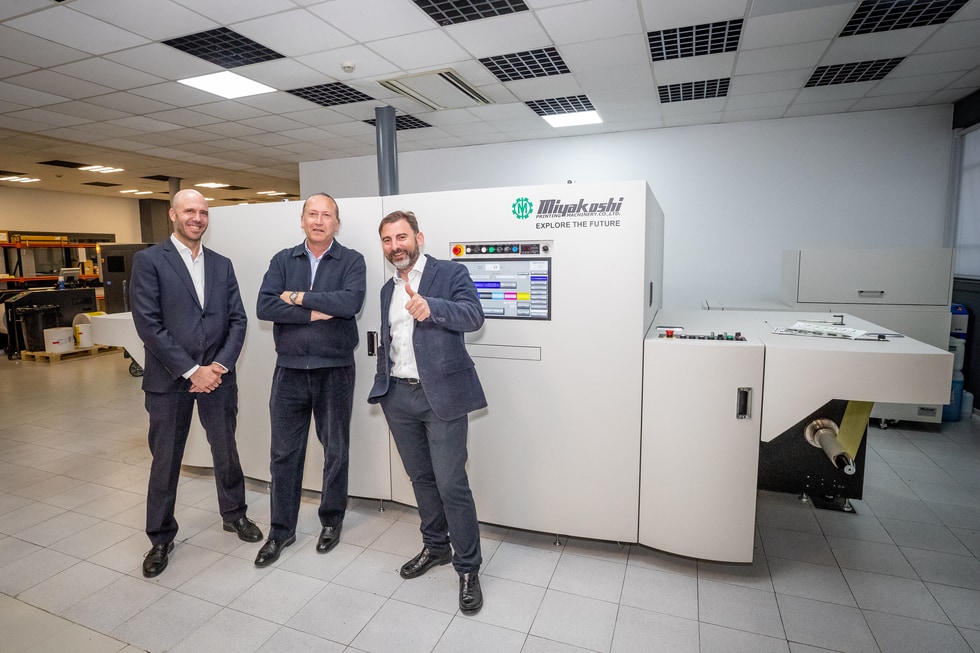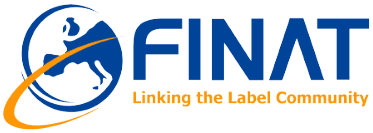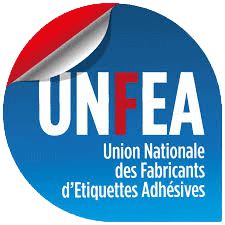With a history of over 75 years of activity in the world of printing, b2Pack manufactures packaging and labels for some of the most demanding customer profiles, including in cosmetics, gourmet foods, and wines and spirits. For a company whose reputation is based on the quality of its manufacture, it is essential to employ the right technology for each project, be it flexography or UV flexo, semi-rotating offset, screen, digital or now inkjet printing with the introduction of the Miyakoshi MJP13LXV, b2Pack is now firmly positioned to handle any packaging or labelling need.
We are greeted by Alberto Sanz, CEO of b2Pack, with whom we began our discussion by talking about the major investment strategy the firm has engaged in over recent years: “We have made a substantial commitment to digital printing in term of response times, variability in models, and special finishes… that’s where we’ve been focusing our investment over the past five years. Nevertheless, and in spite of our excellent reputation and market position, we are not a large label manufacturer. At the production level, our staff numbers less than 30 people, of whom almost 20% are already working in digital, all of which confirms our plans to be active in the use of that technology. We were essentially faced with two choices: to go for volume by partnering or merging with larger players, or to seek a niche strategy involving serving customers who need to customize their output in the form of variable product, offering them greater variety coupled with more responsive and agile operations. We took the second path and bet our business on it, right or wrong.”
b2Pack’s entry into the world of digital printing has been a reality for some time now, backed by a major global supplier of machinery with whom it has partnered for growth through the use of this technology. The recent addition of the new Miyakoshi MJP13LXV unit meshes perfectly with the firm’s commitment to greater use of digital production, thus enabling the firm to handle smaller and more specialized runs, “although we did have to reinforce our digital capabilities because there were still some production runs that we could not handle with our existing digital equipment which, from now on, will be covered with high-quality inkjet printing. Our bet is to embrace the future by covering the whole spectrum,” explains the CEO.
A bet that we can quantify at around three million euros of investment over recent years, efforts that underpin the consolidation of a business that operates a 8,500 square meter facility distributed as follows: 2,500 m2 in warehouse and logistics, another 2,000 m2 in roll labelling, 3,500 m2 in folding (cartons and luxury boxes) and 500 m2 in office space. The plot allows for future growth with an additional 2,000 m2 that can be tapped for expansion as needed. “We do not specialize in label production for a specific market segment, as might others, such as in wineries, for example. Rather, we do it all, although in fact one third of our label output serves the food industry, and another third cosmetics and personal care items,” Alberto Sanz explains, adding that “we are specialists in everything and nothing, something that perhaps has to do not only with our location, Madrid, where there is no dominant product segment as there might be in other areas of the country, such as in the case of wines or fruit and vegetable products. However, this also means that, as manufacturers of cartons and boxes, there are synergies we can tap into that allow us to offer more integrated solutions. A case in point would be our packaging for sliced Iberian ham, for which we can also make the label upon request. We offer a comprehensive service.”
Returning to the topic of digital technology, the CEO of b2Pack believes that digital is above all complementary to the remaining conventional technologies and that the firm must take advantage of all the strengths it can offer for short runs, “but we must be open to the potential for making higher volume runs using variable printing, for example, while introducing some form of aesthetic variation, something that many do not consider today. That is, digital was also born as a print technology that allows for customization, but for now it seems to be typecast as a solution only for short runs, yet, in my opinion, there should be no problem in also covering slightly larger volume runs.”
Why opt for inkjet specifically? The reason for that is that, according to market research, it seems digital technology will be the one that will see the most future growth. Since b2Pack “was somewhat skeptical about inkjet technology at first, given the smell of ink that permeates the label, which is something that, owing to the type of customers that we serve, we can’t afford, as this has a negative impact on product and brand image “, Sanz explains, “so, for us, the deciding factor was that this machine incorporates a nitrogen purging system that all but eliminates the smell of ink. Consumers today are very sensitized and have trouble accepting a label that gives off the smell of ink; imagine making a label for an aromatic product that smells of ink; it’s a real issue. For us, the machine’s nitrogen purge and low odor is critical. And that is something we wish to transmit to our customers”, he continues. “We would like to convey above all two key objectives that digital inkjet equipment allows to simultaneously accomplish: top-tier quality in digital printing with minimal odor. For us, who have been dedicated to high quality cases and cartons for years, the search for excellence is paramount; we never settle for ‘just good enough’.”
“In addition, our inkjet press also features a UV-LED drying system. The elimination of ozone and mercury, as well as the lack of thermal radiation that characterizes this curing technology allows us to work with a wide range of synthetic materials, including a noticeable saving of energy saving without forgoing on-demand production with no wait times. All this perfectly complements its very high print quality, working at 1200 x 1200 resolution, coupled with great ease-of-use and simplicity of operation,” adds David López, head of Miyakoshi Europe.
As for print materials, the new Miyakoshi unit offers a wide range of possibilities “which perfectly complement those of the other digital solutions already in place”, says Sanz.
We also had a chance to talk with the CEO about other challenges that the label industry faces. Sleeves, without going any further. Do they compete with self-adhesive labels? “They have their place. For example, in white wines and sparkling wines you can seeing some applications, but for a red I find it difficult to imagine. Wineries are very traditional in that sense. We see this type of label as something more as a promotional tool, ideal for certain products that need to attract more attention, break with established practices, and so on. But from there to sleeves being employed in high volume, I don’t see it. It will depend on the type of product, but in my opinion, a sleeve often denatures it. Besides, there’s the whole trend against plastic, let’s not forget.”
We approach the end of the conversation by asking Alberto Sanz for the strat line and differentiating message of b2Pack: service as a differential value, understood as “service that comprises going hand in hand with the customer in the creation of a label, from the beginning to the end of the process. We would ideally like to be more involved in the process of creating the design – at the end of the day, we participate in creative design in just over 10% of the work we do – but it is also true that we often assist our clients when they are split between two designs and help them decide by creating a mockup of the bottle, with our label and a case, so that they can see what the actual result would be like. In short, we seek to provide a personalized and comprehensive solution that is not restricted just to the manufacture of the label, but which at client behest may also encompasses its design, its case, outer wrapping, shipping container for logistics… we can accompany the customer throughout this process, from start to finish.”
But are clients aware of the substantial added value that b2Pack is able to offer to users of labels? “It’s hard for customers to always remain abreast of what’s out there,” Sanz acknowledges, “but our sales force expends great effort to publicize not only the fact that we offer a comprehensive solution for their needs, but to communicate with them and explain what the technological innovations we incorporate are capable of and how they might best take advantage of what they can offer in terms of their business interests. We endeavor not to let the conversation be reduced only to pricing. We endeavor to fully grasp the needs of our customers and the potential our company has for accompanying them and helping them to monetize their commitment.
[SOURCE: INFOPACK]








